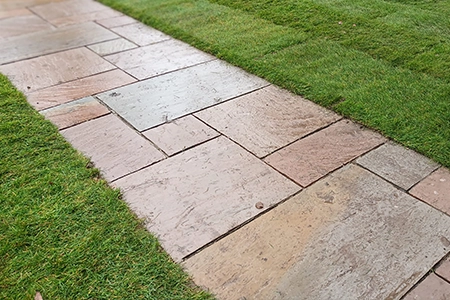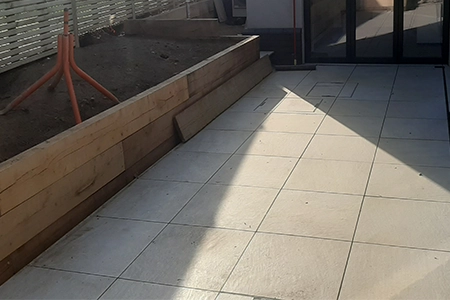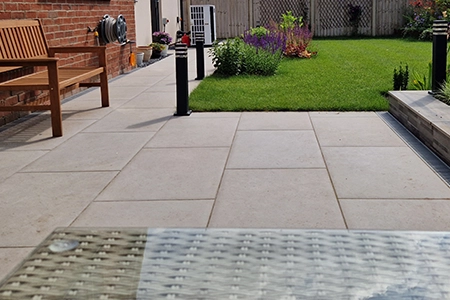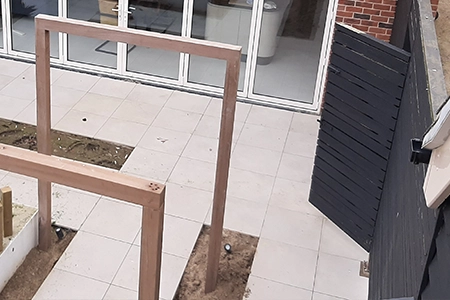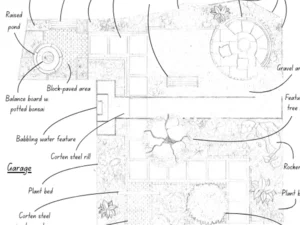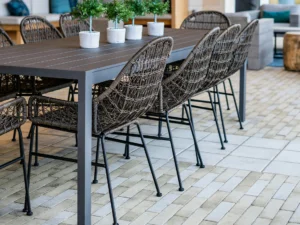Introduction
When it comes to designing outdoor spaces, safety is a top priority. Understanding anti-slip ratings for paving materials plays a crucial role in ensuring these spaces are safe and secure, particularly in areas exposed to moisture. These ratings act as a key indicator of a surface’s slip resistance, offering valuable insights into its safety quotient and should always be considered during the garden design process. Let’s delve into the world of anti-slip ratings, their significance, and how they contribute to creating safer outdoor environments.
The Method Behind Anti-Slip Ratings
The UK’s standards for slip resistance in outdoor paving materials are crucial in ensuring the safety of public spaces and private properties. Two primary measurements, the Pendulum Test Value (PTV) and the Ramp Test Value (R-TV), are commonly used to gauge the slip resistance of these surfaces.
Pendulum test value (PTV)
The Pendulum Test Value is a widely recognised measurement in the UK that evaluates a surface’s slip resistance. It’s conducted using a device called the pendulum tester, which mimics the action of a slipping foot. The test measures the frictional force between the pendulum slider and the surface being assessed. PTV values range from 1 to 100, with higher values indicating greater slip resistance. For outdoor areas prone to wetness, a PTV of 36 or higher is typically considered safe, indicating a surface less prone to slips.
Ramp test value (R-TV)
The Ramp Test Value is another method employed to measure slip resistance, particularly on level surfaces exposed to moisture. This test involves using a ramp inclined at an angle. The R-TV measures the angle at which a person can walk up the ramp without slipping. Surfaces with higher R-TV values provide more resistance against slipping. A value of 40 or above is usually considered suitable for level surfaces subjected to moisture, ensuring enhanced safety in such conditions.
Both these measurements, PTV and R-TV, are conducted through rigorous testing protocols to determine the slip resistance of paving materials. These ratings play a crucial role in establishing safety standards for exterior spaces, allowing property owners and designers to make informed decisions when selecting paving materials for various environments and conditions.
Anti-Slip Measurements and their Meanings
- Pendulum Test Value: The PTV scale ranges from 1 to 100, indicating a surface’s slip resistance. Higher values signify better slip resistance. PTV values are categorised as follows:
- PTV 0-24: High risk of slipping.
- PTV 25-35: Moderate slip risk.
- PTV 36-64: Low slip risk.
- PTV 65 and above: Very low slip risk.
- Ramp Test Values: This rating determines slip resistance by measuring the angle of inclination a surface can have before a person slips while walking. Higher R-TV values signify greater slip resistance. R-TV values are categorised based on the angle:
- R-TV 12-18°: High risk of slipping.
- R-TV 18-24°: Moderate slip risk.
- R-TV 24-35°: Low slip risk.
- R-TV 35° and above: Very low slip risk.
Different Materials and their Anti-slip Ratings
Various materials, from porcelain to natural stone and composite options, offer unique characteristics and anti-slip properties. Understanding how different materials fare in terms of their slip resistance aids in making informed decisions when selecting paving for outdoor areas. Let’s explore how different materials measure up in their anti-slip ratings and contribute to creating safer exterior environments.
Porcelain Paving
Porcelain paving, renowned for its durability and aesthetic appeal, undergoes rigorous testing to determine its anti-slip rating. The rating varies depending on the texture and finish of the tiles. Textured porcelain tiles designed explicitly for outdoor use are engineered to achieve higher anti-slip ratings. These textured surfaces enhance grip and reduce the risk of slips or falls, particularly in wet or moist conditions. Tiles with specific finishes, such as a textured or grooved surface, typically achieve better anti-slip ratings compared to polished or smooth porcelain tiles. To discover more about the intricacies of porcelain paving and its diverse applications, delve into our comprehensive blog on this exquisite paving option.
Concrete Paving
Concrete paving is another commonly used material in outdoor spaces, and its slip resistance is a critical consideration. The anti-slip rating of concrete surfaces depends significantly on their finish. Textured or brushed finishes on concrete paving contribute significantly to achieving better anti-slip ratings. These finishes create a slightly rougher surface, enhancing traction and making outdoor areas safer, especially when exposed to moisture.
Natural Stone Paving
Natural stone, including granite or sandstone, offers a distinctive aesthetic appeal to garden spaces. The slip resistance of natural stone surfaces varies based on the type of stone and its finish. Certain finishes, such as bush-hammered or flamed surfaces, are designed to increase slip resistance. These finishes create a textured surface that improves grip and reduces the risk of slips, particularly in wet conditions.
Composite Materials
Composite materials, including various decking options or composite tiles, are engineered to provide both aesthetic appeal and practical slip resistance. These materials undergo testing to evaluate their slip-resistance properties. Surface treatments and designs are specifically crafted to enhance the anti-slip properties of composite materials. The aim is to create surfaces that balance visual appeal and safety, ensuring outdoor areas are safe, even when exposed to moisture.
Brick Paving
Brick surfaces inherently provide some level of grip due to their texture. However, specific finishes or treatments can further improve their anti-slip ratings for outdoor use. Finishes that create a slightly rougher surface on brick paving enhance traction, thereby reducing the risk of slips and falls. These finishes are especially important in areas that are frequently exposed to wet or moist conditions.
Each of these materials undergoes testing and offers varying degrees of slip resistance, making them suitable choices for outdoor spaces based on their specific characteristics and desired aesthetic appeal. Understanding the anti-slip ratings associated with these materials allows homeowners and designers to make informed decisions when selecting paving materials, ensuring the safety and functionality of exterior areas.
Need more Help with Choosing your Paving?
At NGS, our team leverages its extensive knowledge and expertise in various paving materials to offer tailored guidance to our clients. With a deep understanding of the characteristics, pros, and cons of different materials like porcelain, concrete, natural stone, composite options, and more, we assist our clients in making informed decisions. Whether it’s about selecting the most suitable material for a specific outdoor space or understanding the nuances of anti-slip ratings, our team is dedicated to providing comprehensive support throughout the decision-making process.
If you’re looking to explore further or have specific questions about our expertise in paving materials, don’t hesitate to reach out to us. Visit our Contact Us page to connect with a member of our team who will be more than happy to assist you in discovering the perfect paving solution for your outdoor space.
Conclusion
Understanding anti-slip ratings is pivotal in making informed choices when selecting paving materials for outdoor spaces. By considering these ratings alongside the specific requirements of your space, you can create safer environments without compromising on aesthetics. Prioritising materials with higher anti-slip ratings ensures that your outdoor areas remain secure, even in damp or wet conditions. Safety should never take a backseat in garden design, and by comprehending anti-slip ratings, you’re one step closer to crafting spaces that prioritise both safety and style.

